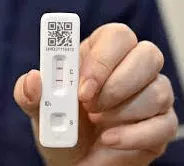
Introduction
Recently, lateral flow tests have gained significant attention as a tool for diagnosing infectious diseases. Their rapid and straightforward nature has made them popular for detecting specific viral infections, especially during outbreaks and pandemics. However, many wonder whether a lateral flow test can pick up any virus or if its effectiveness is limited to certain viruses. In this article, we will delve into lateral flow tests, their mechanism of action, and their limitations when detecting viruses.
1. What is a Lateral Flow Test?
Before we explore the potential of lateral flow tests in detecting viruses, let’s first understand what they are. A lateral flow test is a simple and portable diagnostic tool used to detect the presence of specific substances in a liquid sample. It consists of a strip containing various components, such as capture antibodies and colored particles, which react with the target substance in the model.
2. How Does a Lateral Flow Test Work?
The working principle of a lateral flow test is relatively easy to comprehend. When a liquid sample, such as saliva or nasal discharge, is applied to the sample pad on the test strip, it flows across the strip through capillary action. If the target virus is present in the sample, it will bind to the specific antibodies immobilized on the strip.
3. Target-Specificity of Lateral Flow Tests
Lateral flow cassette tests are designed to be highly specific to particular viruses or other target substances. Each test is engineered to detect one specific virus or a closely related group of viruses. For instance, lateral flow tests are tailored to detect the influenza virus, HIV, COVID-19, and more. This specificity ensures accurate results for the target virus. Still, it also means that the test may not detect other viruses not part of its design.
4. Limitations of Lateral Flow Tests in Virus Detection
While lateral flow tests are valuable tools, they have limitations, especially regarding virus detection. Some of the critical limitations include:
4.1. Sensitivity
Lateral flow tests may have lower sensitivity than other diagnostic methods, such as PCR. This means they might not pick up viral infections in the early stages when the viral load is relatively low. Consequently, false-negative results are possible, leading to the false assumption that a person is not infected.
4.2. Specificity
Though lateral flow tests are specific to certain viruses, they might cross-react with similar viruses, leading to false-positive results. Cross-reactivity can be a concern, particularly when dealing with viruses with similar genetic components or antigens.
4.3. Mutation Impact
Viral mutations can affect the performance of lateral flow tests. As viruses mutate over time, the target-specific antibodies on the test strip may no longer recognize the mutated version, resulting in inaccurate results.
4.4. User Error
The accuracy of lateral flow test results can also be influenced by user error. Improper sample collection or mishandling of the test device may lead to erroneous outcomes.
5. The Role of Lateral Flow Tests in Public Health
Despite their limitations, lateral flow tests are crucial in public health. They are precious in identifying infected individuals in areas with limited access to sophisticated laboratory facilities. Lateral flow tests are widely used in community-based testing programs, airports, schools, and other settings where immediate results are essential for containment measures.
6. Conclusion
In conclusion, Lateral flow cassettetests effectively detect specific viral infections. However, they are not capable of picking up any virus indiscriminately. These tests are engineered with high specificity to target particular viruses, and their accuracy is influenced by factors such as sensitivity, specificity, mutation impact, and user error. Despite these limitations, lateral flow tests remain instrumental in managing infectious diseases, especially in resource-constrained settings.
FAQs – Frequently Asked Questions
Q1: Are lateral flow tests the same as PCR tests?
No, lateral flow tests and PCR tests are different. Lateral flow tests are rapid and provide quick results. In contrast, PCR tests are more sensitive, require laboratory processing, and take longer to produce results.
Q2: Can lateral flow tests detect COVID-19?
Yes, there are lateral flow tests specifically designed to detect COVID-19. They have been widely used in screening programs during the pandemic.
Q3: How accurate are lateral flow tests?
The accuracy of lateral flow tests varies depending on the specific test and the virus it targets. Some lateral flow tests have high accuracy, while others may have lower sensitivity or specificity.
Q4: Can lateral flow tests be used for self-testing at home?
Many lateral flow tests are designed for at-home use, making them convenient for self-testing.
Q5: Are lateral flow tests reliable for asymptomatic individuals?
Lateral flow tests can help identify asymptomatic individuals carrying the virus. Still, their sensitivity may be lower in this group compared to symptomatic individuals.